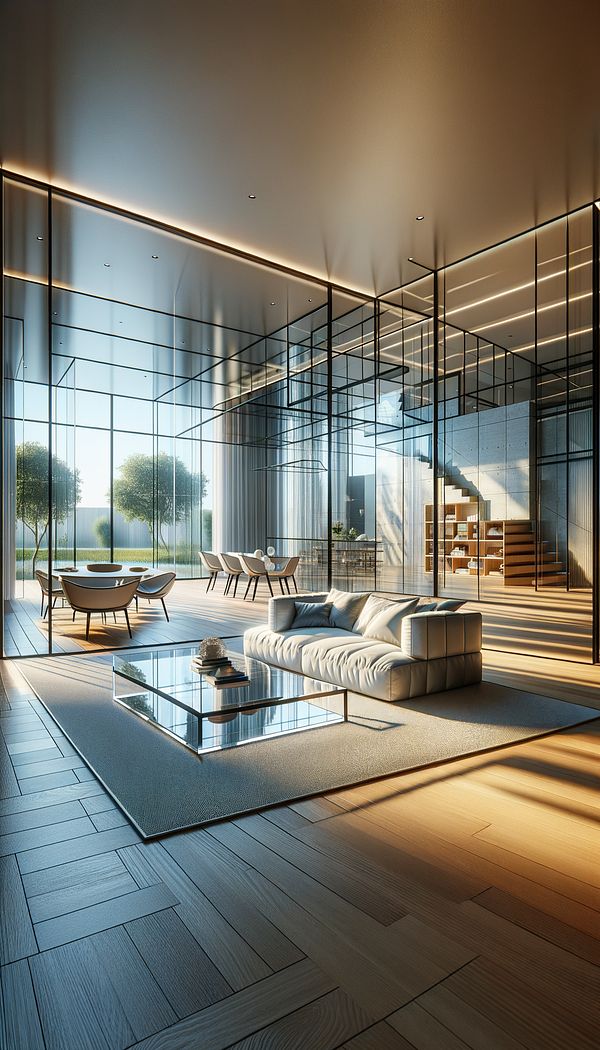What is Glass?
Glass is a hard, brittle, and typically transparent material, made by fusing sand with soda ash and lime, and cooled rapidly.
Description
In the world of interior design, glass plays an indispensable role due to its versatility, aesthetic appeal, and functionality. Its origins trace back to ancient civilizations, where it was primarily used in the form of natural obsidian or as a luxury material in decorative objects. Fast forward to today, and glass has evolved into a crucial element in both structural and decorative aspects of design.
Due to its transparent nature, glass is often used to create illusions of space, making rooms appear larger and more open than they actually are. Its ability to transmit light also makes it a favorite choice for maximizing natural light in spaces, thus enhancing the overall ambiance and mood of an environment. Furthermore, advances in technology have introduced variations such as tempered, laminated, and frosted glass, which offer additional benefits like safety, privacy, and energy efficiency.
Moreover, glass can be manipulated into various shapes and textures, providing endless possibilities for creativity and innovation in design projects. Whether it's sleek glass partitions, statement glass furniture, or intricate stained glass windows, the material’s adaptability allows it to blend seamlessly with any design style, from ultra-modern to traditional.
Usage
Glass is frequently used in a variety of interior design applications, including but not limited to windows, doors, room dividers, shower enclosures, tabletops, shelving, and decorative accents. Its application is not limited to residential spaces; commercial buildings, offices, and hospitality venues also leverage glass to enhance architectural features, improve natural lighting, and contribute to the aesthetics of the environment.
FAQs
-
What are the different types of glass used in interior design?
Common types of glass in interior design include tempered glass for safety, laminated glass for noise reduction and security, frosted glass for privacy, and textured glass for decorative purposes. Additionally, stained glass is often used in windows or decorative pieces to add color and artistic flair.
-
Is glass a sustainable material for interior design?
Glass is considered a sustainable material because it is made from abundant natural resources and is 100% recyclable without loss of quality. However, its sustainable status also depends on the manufacturing process and the efficiency of the recycling systems in place.
-
How can glass improve the lighting in a space?
Glass permits the passage of natural light, reducing the need for artificial lighting during the day. It can also be used strategically in partitions, doors, and windows to direct light into darker areas, enhancing the overall brightness and energy efficiency of a space.
-
Can glass be used in all areas of a home?
Yes, glass can be utilized in virtually any area of a home, from living rooms to bathrooms. However, it's important to select the right type of glass for each application, considering factors like privacy, safety, and thermal efficiency.
-
How do you maintain glass in interior design?
Regular cleaning with a mixture of water and vinegar or a glass cleaner, along with a soft, lint-free cloth, can keep glass surfaces looking their best. Avoid using abrasive cleaners or pads that can scratch the surface.
-
Are there any safety concerns with using glass in interior design?
Safety concerns with glass primarily involve the risk of breakage and injury. Using tempered or laminated glass, which are designed to break into less dangerous pieces or stay intact upon impact, can mitigate these risks. Proper installation and regular inspections are also crucial for safety.
Practical Application
When incorporating glass into your design, consider its placement and purpose carefully. For an airy and bright ambiance, use glass in areas where you would like to maximize natural light, such as near windows or in partitions. For privacy, frosted or textured glass can provide seclusion while still allowing light to pass through. Safety should always be a priority, especially in high-traffic areas or homes with children; in such cases, opt for tempered or laminated glass. Finally, for an artistic touch, explore the use of stained or textured glass to create focal points or accent pieces in your space.
-
Architectural Elements199 articles
-
Design Styles478 articles
-
Lighting111 articles
-
Window Treatments65 articles
-
Materials & Textiles360 articles
-
Square LegA square leg is a type of furniture leg that has a square or rectangular shape.
-
MarbleizingMarbleizing is the process of applying paint or glaze to a surface to imitate the intricate patterns and colors of natural marble.
-
Louis XIIILouis XIII is a style of interior design and architecture originating in France during the reign of King Louis XIII.
-
StrapworkStrapwork refers to a decorative motif featuring interlaced straps or bands.
-
SelvageSelvage refers to the tightly woven edge that runs along each side of a piece of fabric.
